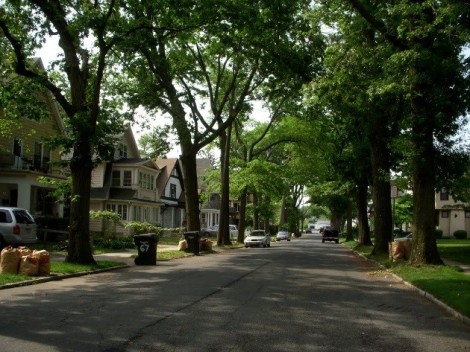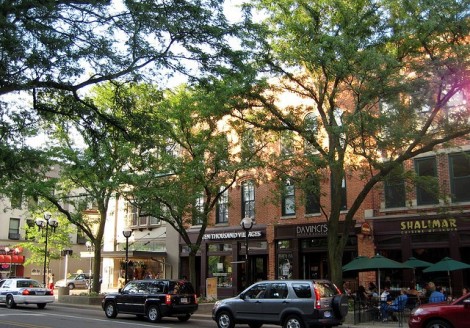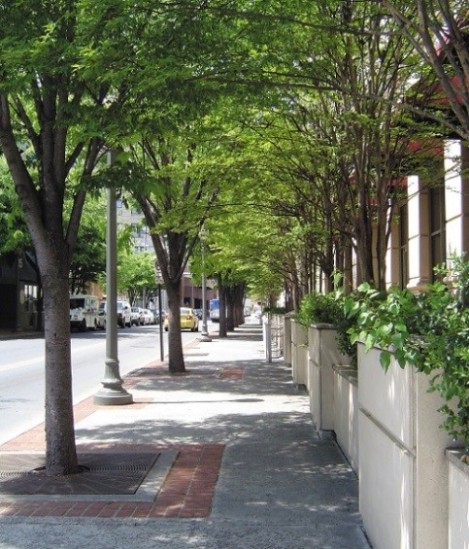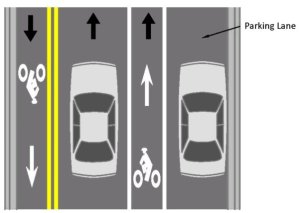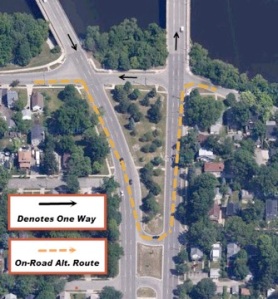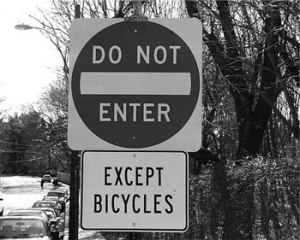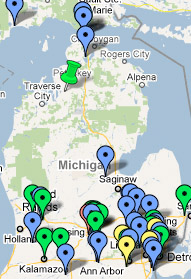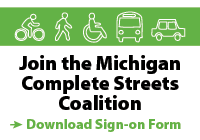You are currently browsing the monthly archive for December 2013.
Roads and sidewalks have undergone dramatic transformations in communities with complete streets policies. More than 90 Michigan communities have passed complete street policies, which contain a variety of design elements that foster a safer, more equitable, and more sensible transportation system. SmartGrowth America tells us complete streets:
“… may include: sidewalks, bike lanes (or wide paved shoulders), special bus lanes, comfortable and accessible public transportation stops, frequent and safe crossing opportunities, median islands, accessible pedestrian signals, curb extensions, narrower travel lanes, roundabouts, and more.”
Nestled in this “more” category are street trees, an often underappreciated asset with a significant impact. On its face, the appeal is obvious: wouldn’t you like to walk down a sidewalk buffered by stately oaks rather than concrete slabs? Look a little deeper, though, and several benefits of properly placed street trees emerge. Street trees may be more important than we give them credit for.
Street trees make pedestrians safer. Ample research has shown that drivers reduce speeds when trees are present, and crashes tend to be less severe. Wide spaces on either side of the street give drivers the perception of a greater room for error, which contributes to higher speeds. Restricting this space and providing a visual edge to the street makes drivers more cautious and drive at lower speeds. Street trees alsocreate a barrier between sidewalks and the road, which gives pedestrians a real and perceived boost in protection.
Street trees also encourage people to walk by creating a more pleasant, aesthetic environment. Often, people walk farther on tree-lined streets because distances seem shorter when walking along greenery. Trees also give scale to urban areas often built in conflict to human dimensions and lend interest to blank sides of buildings. Trees provide shade for pedestrians when walking, shopping or conducting business. The impact on pedestrians frequenting businesses is significant: in one study,businesses on streets lined with trees had a 12% higher income stream than those not lined with trees.
Pedestrian’s physical and mental health also benefit from street trees. The link between time spent in nature and reduced ADHD symptoms has been well explored, but even a walk down a tree-lined street will alleviate symptoms. Street trees have been shown to contribute to decreased obesity rates and improve cardiovascular health by encouraging walking, and parents are more likely to let their children walk to school when sidewalks are tree lined.
The value of street trees in complete street design greatly increases when some of these less-conspicuous benefits are considered. Residents of communities considering adopting complete streets policies should use these benefits as leverage to ensure decision-makers take advantage of trees in complete-street designs.
Written By: Jeff Prygoski, Fellow, Transportation for Michigan
Michigan Department of Transportation’s (MDOT) plans for moving forward with an internal all-out effort on Complete Streets were presented in what was likely the last meeting of the state’s Complete Streets Advisory Council (CSAC) on Thursday, December 5th. The update was another indication that a positive culture shift continues within the agency in regard to planning streets for all users.
Michigan’s Complete Streets Policy implementation plan is nearly finished. The department’s Complete Streets Internal Team is on track to meet its December 31 deadline for rollout of the policy implementation plan, which revises relevant MDOT procedures and guidelines and includes an exception process for projects where policy criteria might not be appropriate, said Brad Peterson of MDOT. Peterson emphasized that outreach will be a major component during the policy’s implementation, including notifications through MDOT’s social media, updated presentations, and a public MDOT Complete Streets webpage tentatively scheduled for early spring 2014.
Brad Peterson of MDOT updates the council on Complete Streets progress
The plan focuses on project tracking and reporting, and will list MDOT’s Complete Streets accomplishments to date. During policy implementation, MDOT staff will receive training on the policy. Several Advisory Council members thanked Peterson and other MDOT representatives for the Department’s positive culture change regarding Complete Streets.
In addition to the implementation plan, MDOT’s Multi-Modal Design and Delivery (M2D2) project is another avenue the department is using to change its internal culture around Complete Streets and multi-modal transportation.
Roger Millar, vice-president of Smart Growth America and director of the Smart Growth America’s Leadership Institute, presented an overview of the project. “The project will improve MDOT’s institutional capacity to plan, design, construct, operate, and maintain Michigan’s transportation system for Complete Streets and multiple modes,” Millar said, noting that it was MDOT managers who approached Smart Growth with the desire to create better multi-modal outcomes. M2D2 will result in updated standards that consider multi-modal travel on state trunkline highway facilities, and will provide MDOT staff with the knowledge and tools to effectively implement multi-modal travel. An MDOT staff stakeholder group will be matched with national and in-state experts to better understand barriers, gaps, and opportunities in MDOT’s practices and procedures. From these meetings, Millar said a curriculum will be developed in early spring, workshops will be held in the summer, and recommendations for implementation will be ready by the fall. MDOT plans on communicating lessons learned to other state agencies, regional and local governments, advocacy groups, and the general public.
Roger Millar of Smart Growth America presents on MDOT’s Multi-Modal Design and Delivery process
The meeting ended with a discussion of whether the council should continue to meet. CSAC was legislatively created with the passage of PA 135 2010, and charged to assist the State Transportation Commission with the development and implementation of the Complete Streets Policy. With the policy done and the implementation plan nearly complete, the council has met it charge. Members of the CSAC voted to send a letter to legislative leaders recommending they sunset the Advisory Council. Barring a new charge or further instruction from the legislature, it seems that CSAC will be dissolved, with members continuing to work on Complete Streets through their respective organizations.
The Complete Streets Policy implementation plan and the M2D2 process are signs that MDOT is continuing its culture shift towards accommodating all legal users on its roadways—not just cars. We look forward to the results of these two initiatives and potential benefits to Michigan communities.
Written by: Jeff Prygoski, Trans4M Fellow
This post continues an ongoing blog series highlighting various complete street elements, their benefits, and use in Michigan communities. Check back often to catch future posts, and keep a lookout for contra-flow bike lanes in your community!
What are Contra-flow Bike Lanes? Contra-flow bike lanes allow legal bicycle access to riders wishing to bike in the opposite direction of traffic flow on one-way streets, creating two-way bicycle access on a one-way street. Contra-flow lanes are placed on the right side of a one-way street (from a bicyclist’s perspective traveling against traffic; from a motorist’s perspective, the lane would be on his or her left). A double-yellow line separates the contra-flow lane from traffic. Because the lanes take bicyclists in the opposite direction of traffic, signage plays an integral role in maintaining safety. “Do Not Enter” and “Bikes Only” signs should be placed at intersections to ensure vehicles do not travel the wrong way.
Why Use Contra-flow Bike Lanes? Contra-flow bike lanes increase connectivity for bicyclists and reduce dangerous wrong-way riding on one-way streets. A great example of how contra-flow lanes accomplish these goals is MDOT’s Martin Luther King/M-99 contra-flow lane. Josh DeBruyn, MDOT Bicycle and Pedestrian Coordinator, reports that prior to installation “cyclists would either cross the road illegally, transition to sidewalk, or travel nearly 10 times the distance while navigating 6 lanes of traffic to make a “Michigan left” to avoid the one-way street, when in reality the bicyclists simply wants to travel straight 150 feet.” In the right situation, contra-flow lanes can be extremely beneficial.
When to Use Contra-flow Bike Lanes: The appropriateness of contra-flow lanes is dependent on bicycling traffic volumes, incidences of wrong-way riding, nearby destinations, vehicle traffic volumes, and road characteristics. The National Association of City Transportation Officials (NACTO) lists several scenarios where contra-flow lanes may be appropriate:
- On streets where large numbers of bicyclists are already riding the wrong way.
- On corridors where alternate routes require excessive out-of-direction travel.
- On corridors where alternate routes include unsafe or uncomfortable streets with high traffic volumes and/or no bicycle facilities.
- On corridors where the contra-flow lane provides direct access to destinations on the street under consideration.
- Where two-way connections between bicycle facilities are needed along one-way streets.
- Work best on low-speed, low volume streets to minimize the risk of dangerous crashes.
Because contra-flow lanes are counterintuitive to drivers, education and outreach efforts are vitally important at the time of installation. Extra signage at driveways and minor intersections will help improve safety. Installing “No Turn On Red” signs at signal-controlled intersections is recommended by NACTO, and would increase safety for bicyclists where drivers make left turns.
Safety Benefits: Because contra-flow lanes formalize wrong-way riding on one way streets, drivers are better notified of bicyclists’ presence. Contra-flow lanes also allow bicyclists to avoid high-traffic detours, where crossing over multiple lanes poses a significant safety risk.
What Drivers Should Know: Drivers should expect to encounter bicyclists in both directions. When making left-hand turns, drivers need to make sure the contra-lane is clear of bicyclist traffic. Passing other drivers in contra-lanes is prohibited, and drivers should be careful not to cross the double-yellow lines.
Cost Considerations: Installation of contra-flow bike lanes should be done in conjunction with road resurfacing, where possible, to reduce costs. Costs will vary greatly depending on the length of the proposed bike lane and the extent of signage needed.
Contra-flow bike lanes are relatively new in Michigan. The Martin Luther King/M-99 contra lane was the first one put in by MDOT. If you have a contra-flow bike lane in your community, please Let us know!
Check out these resources for more information:
NACTO Guidance on Contra-flow Bike Lanes
Federal Highway Administration Guidance
Biking in Bloomington, IN: Contra-flow Lanes
Next Topic: Mid-Block Pedestrian Islands Explained
Previous Topic: Pedestrian Hybrid Beacons (HAWK Signals) Explained

